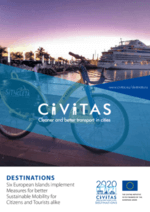
Image by Dreamstime, Georgios Tsichlis
Rethymno (Greece)
Located on the northern coast of the island of Crete, Rethymno is a medium-sized city with growing tourism and mobility sectors. With a population of 63,000, it accommodates more than half a million tourists every year. When also accounting visitors that explore the city on day tours and cruises – to explore its archaeological landmarks, magnificent beaches, traditional villages, cultural events and world-famous gastronomy – the total number of annual visitors climbs to 1.2 million.
As a top-rated tourism destination visited both by air and sea, Rethymno had to address rising challenges from its high seasonal tourism flow and the subsequent strain on the city’s environment and transport system. This works aims to improve local quality of life and to strengthen the city’s image as a green tourism destination. Furthermore, this work complements its involvement in the European Reference Framework for Sustainable Cities and Rethymno's role as a signatory to the Covenant of Mayors since 2011; sustainable mobility is among its strategic pillars.
Local mobility patterns indicated car use as the main transportation mode (60%), with walking and biking accounting for only 20% and 5% of the modal share, respectively. Through CIVITAS DESTINATIONS, Rethymno introduced measures focused on accessibility, active mobility and changing mobility behaviour. Actions promoting electric vehicles (ΕVs), enhancing walking, cycling and road safety, and improving PT and shared mobility services were demonstrated. Rethymno increased sustainable commuting across groups, including school communities, older people and people with disabilities, and saw a significant boost to e-mobility at the regional level.
Fast Facts
63,000 (2019)
Population
1.2 million annually
Visitors
2019
Membership start
Rethymno after DESTINATIONS
Introducing electro-mobility and promoting clean fuels
- + 1 e-bus in public transport (PT) fleet (first nationally), +1 e-car in municipal fleet (first regionally);
- + 4 public e-charging stations; first public e-charging infrastructure in Crete;
- + 18 e-bikes and +1 e-bike for disabled users; new municipal e-bike sharing system;
- + 1200% of new electric private cars (from 2 to 25) from 2016 to 2020;
- + 14 tons CO2 saved thanks to use of e-vehicles in private and public fleets from 2018 to 2020;
- + 7,700 litres of clean fuel-biodiesel used thanks to a new “smart” Used Cooking Oil (UCO) collection system, 2018 to 2020; +226% increased annual UCO recycling rate
Safer and accessible public spaces for vulnerable road users and all
- + 24 countdown timers at traffic lights;
- + 2 SEATRAC systems (automated railed chairs for disabled users to enter the sea), ramps improving beach accessibility, sea guidance systems for people with vision impairment;
- +28 reserved parking places for disabled people with smart parking sensors;
- +5 smart and 10 thermoplastic pedestrian crossings at school entrances.
Smart monitoring and more efficient mobility management
- +11 thermal cameras for monitoring traffic data; + 4 portable traffic monitoring systems;
- + 5 environmental monitoring stations for traffic related pollutants (CO, NOx, VOCs, SO2, ppm, PM10, PM2.5, PM1 and noise);
- + Smart Car Parking Management System, 600 sensors at municipal parking spaces;
- + web-based platform coordinating freight activity in the historic city centre
- - 65% in CO levels and -70% in NOx levels from 2018 to 2021 (note: reduction also due to the impact of COVID-19);
- - 9% vehicles in circulation and -15% congestion episodes, 2018 to 2021.
Change of mind-sets and capacity building towards sustainable mobility
- School communities, local actors and tourism stakeholders have become ambassadors for a car-free lifestyle.
- Established cross sectoral cooperation and win-win partnerships amongst mobility and tourism sector actors towards promotion of sustainable mobility concepts;
- 86% students (6,500 total) engaged in eco-commuting, safe biking and road safety trainings;
- + 3 tailored apps/microsites promoting sustainable modes of daily commuting, eco-driving, new mobility services, clean vehicles and fuels;
- + 60 bus and truck drivers took an ecο-driving training and certification scheme;
- + 15,000 residents engaged in behavioural change events and yearly interactive labs;
- + Tailored sustainable mobility training to enhance skills and motivation of tourism stakeholders;
- + Travel planner app promoting sustainable mobility choices to visitors
- + 9% increase of walking from 2017 to 2021
Approved strategic mobility plans: Upgraded SUMP (Sustainable Urban Mobility Plan) to integrate tourism mobility, and crafted the city's first SULP (Sustainable Urban Logistic Plan) through multi-level participatory and co-creation processes that brought consensus amongst 30+ mobility and tourism stakeholders.
Strong political commitment to sustainable mobility: Rethymno’s Mayor joined the CIVITAS Political Advisory Committee (PAC) in 2018 and has been an active, elected member since then. Local partners’ efforts towards sustainable mobility are widely acknowledged, with Rethymno having received numerous awards at the national and EU levels, including two Best City Awards, 2nd place at the EUROPEANMOBILITYWEEK Awards 2019, and a “Bike Friendly” city distinction. They have transferred their success to three EU cities who followed Rethymno's school action plan through the DESTINATIONS replication funding programme.
Future activities
Through DESTINATIONS, Rethymno brought frontline sustainable mobility concepts to the regional and national levels, demonstrating how – by combining emerging technologies, policy based and soft measures, and strong replication potential – mobility solutions improve cities’ accessibility and attractiveness.
The city's upgraded SUMP defines the next years’ political agenda and delivers mature studies, which have unlocked additional European and State funds amounting to around €7,000,000. Thus, Rethymno will continue delivering SUMP priority measures, and implementing its Strategic Plan for Sustainable Mobility and Road Safety. Local partners, the Municipality of Rethymno and the Technical University of Crete will continue working on building skills and awareness, motivating a wider change of mobility habits, and will capitalise on the experiences gained through DESTINATIONS, scaling up and replicating effective measures.

















